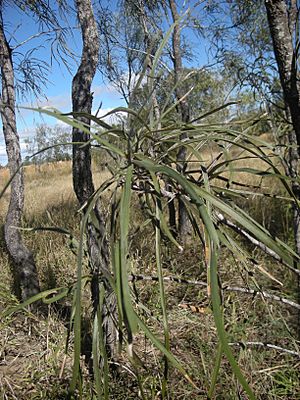Beef oak facts for kids
Quick facts for kids Beef oak |
|
|---|---|
 |
|
| Grevillea striata in coastal Central Queensland | |
| Scientific classification | |
| Genus: |
Grevillea
|
| Species: |
striata
|
 |
|
| Occurrence data from AVH | |
| Synonyms | |
|
List
|
|
The Grevillea striata, often called beefwood, beef oak, or silver honeysuckle, is a type of flowering plant. It belongs to the Proteaceae family and grows only in mainland Australia. This plant can be a shrub or a tree. It has long, thin leaves and flowers that are white, cream, or light yellow. Other names for it include western beefwood and beef silky oak.
Contents
What Does Beefwood Look Like?
The Beefwood tree is usually tall and slender. It can grow from 3–15 m (9.8–49.2 ft) high. Its trunk can be as wide as 60 cm (24 in). It has dark bark with deep cracks.
Leaves and Flowers
Its leaves are long and narrow, like straps. They are often wavy and can be 100–450 mm (3.9–17.7 in) long. The underside of the leaves has 5 to 13 clear lines, which is why it's called striata.
The flowers grow in groups. Each group has up to 12 branches, and each branch is shaped like a cylinder, 50–140 mm (2.0–5.5 in) long. The flowers are white, cream, or pale yellow. They usually bloom from August to December. After flowering, the tree produces a smooth, oval-shaped fruit called a follicle, which is about 13–21 mm (0.51–0.83 in) long.
Why is it Called Beefwood?
The name Grevillea striata was first given to this plant in 1810. A botanist named Robert Brown described it. The word striata means "striate," which refers to the lines on the underside of its leaves.
This tree is called beefwood because its inner wood is a deep red color, much like beef.
Where Does Beefwood Grow?
Beefwood trees grow in woodlands and areas with shrubs. They can also be found in places with spinifex grass. They grow in many different types of soil. You can find them in all mainland Australian states, except Victoria.
A Tree with a Story
Some Beefwood trees live for a very long time. There's a famous tree that still stands today. It has an inscription carved into it from 1845. This carving is a memory of James Poole. He was part of an expedition led by Charles Sturt. James Poole became very sick and died. He was buried near a Beefwood tree at Preservation Creek in Milparinka. The carving "JP 1845" was put on the tree to remember him. The tree must have been quite old already when the carving was made!
How People Use Beefwood
Beefwood has been useful to people for a long time.
Traditional Uses by Aboriginal People
Aboriginal people used a sticky resin from the tree. They used it to attach stone tools, like flints, to handles. They also used charcoal from the tree. It was believed to help heal wounds.
Building and Timber Uses
Early settlers found Beefwood timber very useful. It is strong and easy to split. They used it for fence posts, roof shingles, and even for flooring. The wood is very heavy and dense. This makes it a very durable and strong material.
See also
 In Spanish: Grevillea striata para niños
In Spanish: Grevillea striata para niños



